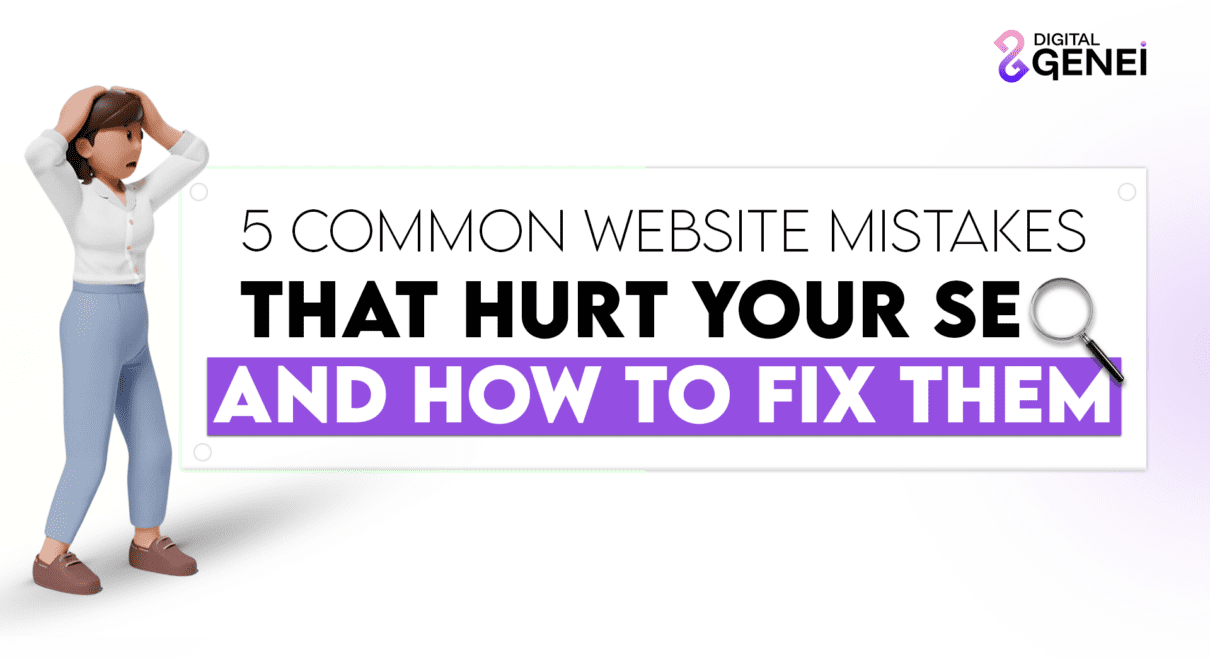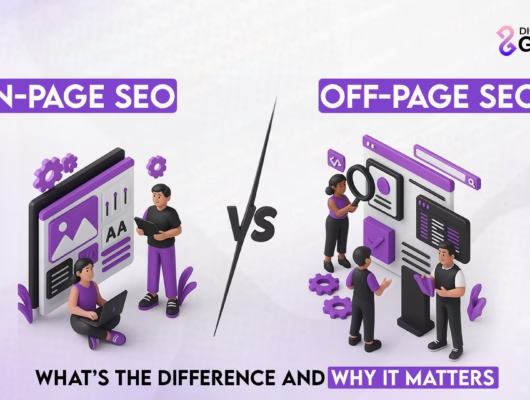Many businesses struggle with poor search visibility, low traffic, and disappointing conversion rates. What they don’t realize is that these problems often stem from silent SEO issues embedded deep within their website structure, design, or content.
At Digital Genei, we’ve worked with countless clients facing the same challenge: their websites look fine on the surface, but underneath, they’re making fundamental mistakes that cost them rankings, traffic, and business. If you’re new to SEO and want a detailed introduction, check out our Beginner’s Guide to SEO for small business owners.
Below, we break down the five most common website mistakes that hurt your SEO and offer practical steps to fix each one.
1. Slow Website Speed
Website speed is not just a user experience issue, it’s a ranking factor. A delay of even one second can result in a 7% decrease in conversions. Google prioritizes websites that offer a fast, seamless browsing experience, and users expect nothing less.
How to Fix It:
- Compress and convert images to next-gen formats such as WebP.
- Minify JavaScript, CSS, and HTML to reduce load time.
- Enable browser caching and GZIP compression.
- Invest in a high-performance hosting provider.
Recommended Tool: Google PageSpeed Insights
Fast websites rank better, retain users longer, and convert more efficiently.
2. Poor Mobile Optimization
With more than 80% of global web traffic now coming from mobile devices, mobile optimization is no longer optional. A site that isn’t responsive will lead to poor engagement metrics and search engines will penalize it accordingly.
How to Fix It:
- Use a responsive framework that adapts content across all devices.
- Ensure fonts are legible and buttons are spaced appropriately for mobile use.
- Avoid intrusive pop-ups that block content on smaller screens.
- Regularly test your site on different screen sizes and devices.
Recommended Tool: Google’s Mobile-Friendly Test
A mobile-first experience is essential for both users and SEO success.
3. Lack of Internal Linking
Internal linking plays a key role in helping search engines understand the hierarchy and structure of your website. It also keeps users on your site longer by guiding them toward relevant content or services.
How to Fix It:
- Strategically link relevant blog posts, service pages, or case studies within your content.
- Use descriptive, keyword-relevant anchor text instead of vague phrases like “click here.”
- Regularly check for and fix broken links.
- Ensure every important page is linked to from at least one other page on your site.
Internal linking improves crawlability, enhances user flow, and strengthens page authority.
4. Weak or Missing Meta Tags
Meta titles and descriptions are your first chance to attract a user’s attention in search results. Poorly written or missing meta tags can lead to lower click-through rates, even if your page ranks well.
How to Fix It:
- Write unique, keyword-rich meta titles (ideally under 60 characters).
- Write meta descriptions that are clear, compelling, and under 160 characters.
- Avoid duplicate tags across different pages.
- Align meta content with user intent and the on-page content.
Example: A poor meta title like “Welcome Page” can be improved to something more descriptive and keyword-rich, such as “Expert Digital Marketing Solutions | Digital Genei.” Well-structured meta tags improve both visibility and user engagement.
5. Thin or Duplicate Content
Search engines prioritize quality over quantity. Pages with little to no original content, outdated information, or content duplicated across multiple URLs can lead to ranking penalties or deindexing.
How to Fix It:
- Avoid copying and pasting content from other parts of your site or from other sources.
- Develop original, valuable content for each page that addresses user needs.
- Keep your blog updated with fresh, relevant insights and case studies.
- Use tools like Copyscape or Siteliner to detect duplicate content.
Long-form, in-depth content (1,000–1,500+ words) that demonstrates authority consistently performs better in search rankings.
Conclusion: Fix Your SEO Foundation
SEO success goes far beyond simply using the right keywords or building backlinks. It requires creating a technically sound, user-friendly website with well-structured content and strong foundational elements.
By addressing these five common website mistakes, improving site speed, optimizing for mobile, building effective internal links, writing compelling meta tags, and ensuring high-quality, original content, you can significantly enhance your search engine rankings, increase organic traffic, and boost conversion rates.
Taking the time to fix these core issues lays the groundwork for sustained digital growth and a stronger online presence. Want to find out what’s holding your website back? Get in touch with our team for a custom website and SEO audit.






